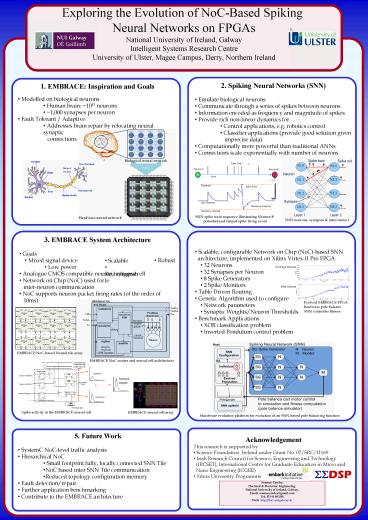Acknowledgement - PowerPoint PPT Presentation
1 / 1
Title:
Acknowledgement
Description:
Irish Research Council for Science, Engineering and Technology ... Web: http://birc.nuigalway.ie. 1. EMBRACE: Inspiration and Goals. 2. Spiking Neural Networks (SNN) ... – PowerPoint PPT presentation
Number of Views:1071
Avg rating:3.0/5.0
Title: Acknowledgement
1
- 2. Spiking Neural Networks (SNN)
- Emulate biological neurons
- Communicate through a series of spikes between
neurons - Information encoded as frequency and magnitude
of spikes - Provide rich non-linear dynamics for
- Control applications, e.g. robotics control
- Classifier applications (provide good solution
given imprecise data) - Computationally more powerful than traditional
ANNs - Connections scale exponentially with number of
neurons
1. EMBRACE Inspiration and Goals
- Modelled on biological neurons
- Human brain 1013 neurons
- 1,000 synapses per neuron
- Fault Tolerant / Adaptive
- Addresses brain repair by relocating neural
synaptic connections
Biological neural network
SNN spike train sequence illustrating Neuron B
potential and output spike firing event
Hardware neural network
SNN neurons, synapses interconnect
- 3. EMBRACE System Architecture
- Goals
- Mixed signal device
- Low power
- Analogue CMOS compatible neuron/synapse cell
- Network on Chip (NoC) used for inter-neuron
communication - NoC supports neuron packet firing rates (of the
order of 10ms)
- Scalable, configurable Network on Chip
(NoC)-based SNN architecture, implemented on
Xilinx Virtex-II Pro FPGA - 32 Neurons
- 32 Synapses per Neuron
- 8 Spike Generators
- 2 Spike Monitors
- Table Driven Routing
- Genetic Algorithm used to configure
- Network parameters
- Synaptic Weights/Neuron Thresholds
- Benchmark Applications
- XOR classification problem
- Inverted Pendulum control problem
- Robust
- Scalable
- Reconfigurable
Average fitness
Best fitness
Evolved EMBRACE-FPGA hardware pole balance SNN
controller fitness
EMBRACE NoC-based Neural tile array
EMBRACE NoC-router and neural cell architecture
Spike activity in the EMBRACE neural cell
EMBRACE neural cell array
Hardware evolution platform for evolution of an
SNN-based pole balancing function
- .
- Acknowledgement
- This research is supported by
- Science Foundation Ireland under Grant No.
07/SRC/I1169 - Irish Research Council for Science, Engineering
and Technology (IRCSET), International Centre
for Graduate Education in Micro and Nano
Engineering (ICGEE) - Xilinx University Programme
- 5. Future Work
- SystemC NoC-level traffic analysis
- Hierarchical NoC
- Small footprint fully, locally connected SNN
Tile - NoC based inter SNN Tile communication
- Reduced topology configuration memory
- Fault detection/repair
- Further application benchmarking
- Contribute to the EMBRACE architecture
Seamus Cawley Electrical Electronic
Engineering, National University of Ireland,
Galway. Email seamuscawley_at_gmail.com Tel 353 91
493301 Web http//birc.nuigalway.ie































